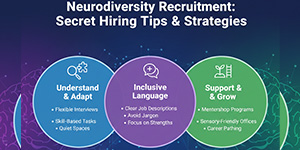Skills Gap Analysis: Hiring for Future Workforce Skills
Companies who are adjusting to fast-changing industries that are affected by digital transformation, automation, and changing customer expectations have found that skills gap analysis is one of the most important tools they can use. This is why skills gap analysis is so important for long-term planning. It helps businesses figure out what talents they will need to hire in the future, build stronger talent pipelines, and create targeted upskilling programs.
A good skills gap analysis may help you hire the right people by making sure that your staffing decisions are in line with industry trends and predicting the talents that employers will need in 2030. This method also helps workers learn new skills that will help them in their future jobs. It lets companies compare what their current employees can do with what they will need to do in the future and make a clear skills gap report that helps them hire people with the right talents and makes them more resilient.
 |
Importance of Skills Gap Hiring Strategy in Future Skill HiringTo assist organizations, get through modern upheavals, they need a good skills gap hiring strategy. |
When businesses plan for hiring future capabilities, they make sure that their hiring efforts are not just based on current needs, but also on new technology, changing consumer tastes, and new market demands. AI adoption, automation, and digital innovation are changing a lot of industries. If organizations don't have a good plan for employing people with the right capabilities, they could slip behind competitors who get ready early.
By using skills gap analysis in hiring, corporate executives may tell if their employees will be able to do their jobs in the future. This helps close the skills gap in the workforce by showing which teams need specific training and which sections need outside aid. Companies not only get better results when they hire people with the right talents, but they also keep employees longer because they feel more supported through structured career development.
When paired with skills predicting recruitment, this method becomes even more effective. Companies can plan for changes in their workforces and know what skills employers will need in 2030. Hiring managers can change job descriptions, create training routes, and make sure that hiring for future capabilities is part of the organization's long-term sustainability model through this planning.
Using Skills Forecasting Recruitment to Improve Skills Gap Recruitment
- Skills forecasting recruitment plays a vital role in supporting skills gap recruitment by projecting what competencies will be essential in upcoming years.
- Instead of relying on outdated job profiles, this method uses data, industry trends, and emerging technologies to determine what future talent will require.
- When companies use future skills hiring insights, they avoid the common problem of hiring individuals who may not be able to grow with their roles.
- With skills forecasting recruitment, organizations can assess existing workforce strengths and detect the workforce skills gap more accurately.
- This method is closely connected to how to do skills gap analysis for hiring because it guides employers in evaluating whether the current staff is prepared for the evolving job landscape.
- Once gaps are identified, they can craft a structured skills gap hiring strategy that aligns recruitment processes with future needs.
- This ensures that skills gap recruitment does not rely on guesswork but on real data about changing job demands.
- As companies gather these insights, they can produce a comprehensive skills gap report for businesses.
- This report strengthens the justification for new hiring initiatives and provides HR leaders with solid evidence to request budget allocations for workforce upskilling for future job roles.
- Through these efforts, skills forecasting recruitment reduces uncertainty, enhances decision-making, and improves long-term organizational performance.
Workforce Skills Gap Challenges and Solutions for Hiring for Future Skill
Even though the workforce skills gap analysis works quite well, a lot of companies still have trouble closing the skills gap in their workforce. Keeping up with how quickly technology develops is one of the hardest things to do. As AI and automation tools get better, job responsibilities change quicker than corporations can teach their workers. This makes it even more important to hire people with the right talents for the future. Companies that don't get ready properly may have trouble adapting and lose production.
Another problem is that it's hard to know what skills businesses will need in 2030. A lot of business leaders don't know what talents will be important in five or 10 years, which makes it hard to come up with good plans for employing people with the right skills. This uncertainty often causes job criteria to not match up and skills gap recruitment to not work. To stay away from these problems, businesses need to use data-driven strategies like skills forecasts recruitment, industry analytics, and performance appraisals for employees.
The good news is that regular skills gap analysis can help you get past these problems. When businesses know how to undertake a skills gap analysis for hiring, they may look at job roles again and change their hiring plans for future skills needs. They can also make a skills gap report for businesses to help them keep track of their progress and plan for long-term workforce upskilling for future employment roles. Over time, this proactive strategy lowers risks and makes sure that the workforce is still flexible, ready, and able to meet the needs of the sector.
Developing a Strong Skills Gap Recruitment Plan
To meet both present and future recruiting demands, it's important to make a good skills gap recruitment plan. When companies hire for abilities that will be needed in the future, they need to think about which skills are growing more valued and how these skills affect the growth of the firm as a whole. A good hiring plan makes sure that job postings focus on the talents that businesses will need in 2030 instead of abilities that might soon be out of date. This forward-thinking method helps businesses find applicants who can grow with the organization.
To make a good plan for recruiting people with skills gaps, you also need to know a lot about the skills gaps in the workforce. Employers should look at how well their employees are doing, figure out what their departments are lacking, and decide what extra skills are needed to finish big projects. Companies can improve their hiring criteria and avoid hiring people who don't have the potential to grow by using this information along with a defined skills gap hiring approach. This method makes it easier to hire people with the skills needed for the future and keeps the workforce stable over the long term.
Organizations should also use skills forecasting recruitment to improve job descriptions and hiring channels. Employers can learn how to undertake skills gap analysis for hiring and make more accurate hiring profiles by doing this. Employers may then make a useful skills gap report for business to help them make strategic decisions. This will make it easier to hire new employees and train them for future job opportunities.
Designing Workforce Upskilling for Future Job Roles Through Skills Gap Analysis
Importance of Workforce Upskilling
Modern business planning must include upskilling the workforce for future jobs. Companies who put money into this process close the skills gap in their workforce and make it easier for employees to go forward in the company. This method makes sure that hiring for future talents doesn't just rely on hiring from outside the company, but also makes the most of the skills of current employees. Companies can figure out the talents they need to create in-house to fulfill future company needs by doing a skills gap analysis.
Preparing for Future Skills Employers Need 2030
One of the best things about upskilling the workforce is that it helps people learn the skills that companies will require in 2030. Companies need to get their workers ready for digital tools, automated workflows, and data-driven environments as new technologies come out. To help with this change, companies need to learn how to undertake a skills gap analysis for hiring and figure out which skills can be taught and which ones need to be hired from outside the company. This mix helps make a hiring plan that fills in the gaps in capabilities while also supporting long-term sustainability.
Creating a Skills Gap Report for Strategic Planning
When companies make a skills gap report for businesses, they can see clearly where they are lacking in leadership, technical abilities, and soft skills. This paper serves as a guide for creating upskilling programs and finding people to fill skills gaps. Companies may get ahead of changes by combining skills forecasts with recruiting data. This way, they can make sure that upskilling their workers for future job roles is still planned and in line with hiring for future capabilities.
How to Do Skills Gap Analysis for Hiring Using Skills Gap Hiring Strategy
Understanding the Importance of Skills Gap Analysis
Understanding how to do skills gap analysis for hiring is essential for creating a strong skills gap hiring strategy. Employers must begin by evaluating current employee performance, assessing departmental functions, and defining the competencies needed to achieve business goals. These activities help reveal the workforce skills gap and allow organizations to prioritize future skills hiring. The goal is not only to understand current shortcomings but also to identify the future skills employers need 2030.
Conducting an Accurate Skill Gap Analysis
To do a good job of analyzing, employers should look at job descriptions, look at technical requirements, and get comments from supervisors. This information helps with skills gap recruitment by telling the team exactly where they need more knowledge. Companies can change their recruiting plans and make sure they hire people who can help them reach their long-term goals by using skills forecasting recruitment. This study also helps companies come up with better ways to hire people with the talents they will need in the future, rather than only focusing on what they need right now.
Creating a Skills Gap Report for Strategic Action
Once the data is collected, companies can produce a skills gap report for business to document their findings. This report supports workforce upskilling for future job roles by highlighting key areas where internal training is necessary. By aligning the report with a structured skills gap hiring strategy, companies can approach recruitment and training with clarity, intentionality, and measurable goals.
Measuring the Results of Future Skills Hiring and Skills Gap Recruitment
Tracking the Effectiveness of Future Skills Hiring
Measuring the effectiveness of future skills hiring is critical for improving recruitment efforts. After implementing a skills gap hiring strategy, employers must track whether new hires are meeting performance expectations and filling the workforce skills gap. This evaluation reveals whether the organization has successfully anticipated future needs or whether adjustments are required. Companies that consistently measure results better understand the future skills employers need 2030.
Identifying Success Indicators
Success indicators can include productivity improvement, employee adaptability, internal promotions, and reduced turnover. These metrics help determine whether the skills gap recruitment process is attracting the right talent. Additionally, employers should use skills forecasting recruitment insights to assess how future roles may evolve. This ensures that hiring for future skills remains aligned with long-term organizational goals.
Using Results to Improve Workforce Development
Companies can use these insights to improve their skills gap report for businesses and make training programs better for those who want to learn new skills for future jobs. This method of continuous improvement helps firms make better decisions about how to undertake skills gap analysis for hiring, which leads to better workforce development over time.
Conclusion
One of the best things that companies can do to get ready for the future is to do a skills gap analysis. Companies get the information they need to close the skills gap in their workforce, hire people with the right talents in the future, and make strategic recruitment plans through this procedure. A good hiring strategy that focuses on closing the skills gap helps companies find the right people for the job and make sure they have the abilities they need in the future.
Companies become more resilient and able to adapt to constant change when they also train their employees for new job roles. Companies can make sure they keep growing and build a competitive workforce for the future by learning how to undertake a skills gap analysis for hiring and making a full skills gap report.
FREQUENTLY ASKED QUESTIONS
1. What is skills gap analysis in hiring?
It is a method used to compare current employee skills with future job requirements to identify missing competencies and plan recruitment.
2. Why is future skills hiring important?
Because industries are changing quickly, and employers must prepare for the future skills employers need 2030 to stay competitive.
3. How does skills gap recruitment benefit businesses?
It helps companies hire strategically by identifying exact skill shortages and aligning candidates with long-term needs.
4. What is skills forecasting recruitment?
It is a technique that predicts future talent needs based on industry trends, data, and evolving job market demands.
5. How can companies reduce the workforce skills gap?
They can combine hiring for future skills with internal workforce upskilling for future job roles to strengthen employee capabilities.
6. What is included in a skills gap report for business?
The report outlines skill shortages, future talent needs, recommended training programs, and hiring priorities.
7. How do I start creating a skills gap hiring strategy?
Begin by understanding how to do skills gap analysis for hiring, gather data, review job requirements, and align recruitment with future goals.





